Designed for children ages 60-72 months, this easy-to-use, comprehensive curriculum is FREE for immediate family and in-home use. Use as a transitional kindergarten or kindergarten curriculum according to your state's requirements. If you intend to use the curriculum in a preschool, church, or daycare setting, please refer to the Complete 5 Year Curriculum.
Each Online Lesson Plan includes:
To get started, choose objectives and activities that suit your child's needs and situation. Please know that the Week 1 Lesson Plan is significantly longer to help you begin. Incorporate them into your child's daily routines to create a seamless and enjoyable learning experience. This flexible approach allows you to customize the curriculum to fit your unique situation, ensuring a solid foundation for your child's growth and development.
Order Supplies Quickly order supplies in the ABCJLM Amazon Shop.
| The 5 Year Curriculum can be used as a transitional kindergarten or kindergarten curriculum according to your state's requirements. The objectives are the learning goals that you introduce to the child over one week. Don’t feel the need to cover all the focused objectives each day. Instead, spread them throughout the week. As much as possible, pull the learning from the play and activities that the child is doing. |
Theme: Trinity
Bible Story: God the Father
Objective: God is my Father and He loves me.
Scripture: Genesis 1, I John 3:1a
My First Hands-On Bible: pg 10-21
Verse: I John 3:1 (NIV84) - How great is the love the Father has lavished on us, that we should be called children of God! And that is what we are!
Tune: 10 Little Indians
How- great- is the- love the
Father- has lavished on us,
that- we should be- called
the children of God.
And that is what we are,
And that is what we are,
And that is what we are,
First John three- one.
Bible Song: Trinity Song
Tune: Are you Sleeping?
God the Father, God the Father
God the Son, God the Son
God the Holy Spirit, God the Holy Spirit
Three in One, Three in One.
Books of the Bible: Genesis, Exodus, Leviticus, Numbers, Deuteronomy
Math: All Shapes and Colors
Science: Calendar - Days and Weeks
Social Science: Weather - Sunny, Cloudy
Letters: I, i
Numbers: Point to and Count 0-5
Literacy: How to Care for a Book
Sight Word: I
Book of the Week:  Blueberries for Sal by Robert McCloskey
Blueberries for Sal by Robert McCloskey
Fine Motor Skill: Draw "My Family"
Gross Motor Skill: Put the Fire Out
Visual Perception Skill: Coloring Tracking Worksheets
 |
Feeling Overwhelmed About Where to Start?Beginning intentional learning with your child can feel daunting, but you're not alone on this journey. I'm here to help! I offer 30-60 minute training sessions tailored for you, your spouse, or both of you together. |
| Because busy lives make it difficult to think of activities that pair well with learning objectives, I’ve provided suggestions to help you teach the week’s objectives. Choose activities that your child would enjoy and that fit into your schedule. As often as possible, achieve the learning from books, play time, craft time, and current activities. |
Unique to the 5 Year Curriculum, the child is introduced to Bible themes to help your child understand God beyond the basic Bible stories from their preschool years. The Objective section includes page numbers to My First Hands-On Bible (when available), but any quality age-appropriate children’s Bible may be used. To end the week, read the story from the Bible. Activities are provided in the Lesson Plan to provide additional information as you teach and reinforce what the child is learning about the truth of God’s Word.
Bible Activities: God the Father
- Introducing the Bible Story
Begin by reading Genesis 1. God is called the Father because He created the world. God made us - His children - because He loves us. Further this lesson with ABCJesusLovesMe Creation Activities. Next read I John 1:3a. Discuss what a father is and what loving fathers do. Loving fathers care for their children. This means that fathers provide for their children's needs and give their children what is good for them.
- Who is God the Father?
God is called the Father because He created the world and us. Because God is the ultimate Father, the words "God the Father" is always capitalized. God is the Father of all people.
God shows His love to us by forgiving and forgetting our sins.
God has no beginning or ending.
God is everywhere at once - omnipresent.
God is perfect and knows everything - omniscience.
God is all-powerful - omnipotence.
(Although the "omni-" words are difficult, most children love to learn big words.)
- 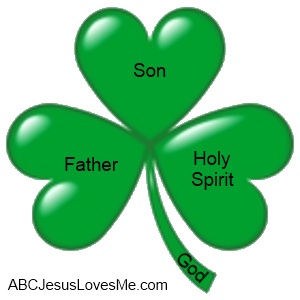
Although the concept of God being three-in-one is too hard for even adults to understand, it is important to introduce children to the Trinity. Start by sharing the Shamrock worksheet with the child. Label the stem "God." Explain that God is showed to us in three ways. This week, introduce the child to "God the Father" as one part of the Trinity. Have the child label one leaf "Father."
- Teachable Moments
As you go about your day, ask your child: Who is always with you? Beside mommy, who loves you no matter what? Who knows everything about you? (God)
- 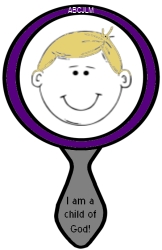 I am a Child of God.
I am a Child of God.
Have the child draw a picture of himself in the mirror of the I am a Child of God" worksheet. (Combine this activity with the Fine Motor Skill drawing.)
-  Using Flannelgraph
Using Flannelgraph
While it is an investment, for toddler and preschoolers I believe flannelgraph is one of the best ways to teach Bible stories. Because of this, in each lesson plan, you will see story numbers associated to the Betty Lukens Through the Bible in Felt Teacher Manual. The Bible story, as well as a list of the needed flannelgraph scenes, characters, and props, are listed to help you tell the story. Read more about "Using Flannelgraph."
Memory Verse: I John 3:1
Each week includes a simple memory verse. Help the child memorize at least the key words. Discover helpful memory verse tips. Remember to say each short phrase very slowly with the child.
- Verse Actions
great - arms open wide
love - arms crossed across the chest
Father - point up in the air with index finger
lavished (given) - both hands "give" something
us, we - point thumbs at chest
children - move hands outward as if patting children's heads
God - point up in the air with index finger
And that is what we are! - shout with fist cheers
Bible Song: Trinity Song
The carefully selected Bible songs are beloved classics sung in Sunday School throughout the generations. Learning these tunes helps the child memorize verses and Bible stories while connecting them to strong theological truths. If any of these songs are unfamiliar, I've created free videos of each one, complete with actions, to help you learn them easily.
Sing this song very slowly and incorporate the actions throughout the day. Create a tradition of singing it during bath time, while driving, or as part of your bedtime routine. As you sing this song to the child repeatedly, they will gradually start to join in.
Books of the Bible: Genesis, Exodus, Leviticus, Numbers, Deuteronomy
;
To study the Bible, I believe everyone should know the order of the books of the Bible. With a little help, most preschool children can master this task. Because of its importance, I have added this to both the 4 and 5 Year Curriculum. Children using the 4 Year Curriculum learn the New Testament books while children using the 5 Year Curriculum learn the Old Testament books. Every two weeks a new set of books is added. Use a song (as shared above), motions, or simply repetition to help your child. Click for more ideas on learning the Books of the Bible.
Math, science, and social science activities are included to help the child understand such topics as: patterns, counting, calendars, sorting, life cycle, community, transportation. As early elementary concepts, some of these objectives may be too difficult for a child. And that’s okay. Introduction is key and retention is an added bonus!
Math: All Shapes and Colors
During this week affirm that your child knows all of the basic shapes (oval, heart, rectangle, triangle, circle, square, star, diamond) and colors (black, white, blue, brown, green, yellow, orange, red, purple). Play games with shapes and colors for additional practice if needed.
Numbers: Point to and Count 0-5
Gather five items. Point to and count from 0-5. Make sure that each item is pointed to and counted only once.
Science: Calendar - Days and Weeks
Song: Seven Days Author Unknown
Tune: Are You Sleeping? or Where is Thumbkin?
Seven days, seven days
In a week, in a week
Sunday, Monday, Tuesday
Wednesday, Thursday, Friday
Saturday, that’s a week
Social Science: Weather - Sunny, Cloudy
 Calendar and Weather Wall Chart
Calendar and Weather Wall Chart
The first eight weeks of the Basic 5 Year Curriculum focuses on the calendar, weather, and seasons. A calendar and weather wall chart is a strong supplement to these units to help further the learning throughout the curriculum. You can purchase wall charts online or make your own by using a Big Print Wall Calendar and Weather Symbols worksheet. For an online version, Starfall.com offers an interactive option.
Sunny -
- Dress: Sunglasses, hat, sunscreen, shorts, t-shirt
- Science: God perfectly distanced the sun and earth so that the sun keeps us warm, but not too warm. The sun also provides us with light. Use a balloon to represent the earth and the child to represent the sun. Instruct the child that the sun does not move. (This may be very difficult for some children!) Mark the balloon representing where you live on the earth.
Demonstrate:
Day and night - Rotate the balloon 360 degrees to show where you live compared to the sun.
Warm and cool - Discuss how it is warmer during the day (when the sun is shining on the place you live) and cooler at night (the sun is shining on the opposite side of where you live).
Year - Rotate the earth around the sun and say the months of a year. Discuss how a complete rotation is a year or another birthday.
-  Sun Craft
Sun Craft
Draw a circle on a piece of white paper. Drop large dots of yellow paint inside the circle along with a very small dot of red paint. Lay a piece of wax paper on top of the circle. Press with the pads of your fingers to mix the paint and cover the circle. Pull up the wax paper. With a q-tip, pull extra paint from the circle to make sun rays.
Cloudy -
- Clouds are small collections of very small droplets of water. The droplets are so small and light that they can float.
- Dress: Depending on the season, cloudy weather may mean you need to wear warmer clothes.
-  Cotton Ball Clouds
Cotton Ball Clouds
Glue cotton balls on a piece of blue construction paper to form different sized clouds.
-  Surprise Cloud
Surprise Cloud
With a white crayon firmly draw clouds on a piece of paper. Using diluted blue paint, have the child paint the entire piece of paper to find the clouds. Count the clouds that are discovered.
The handwriting worksheets in the Basic 5 Year Curriculum provide opportunities for the child to write the Letter and Number of the Week while diving into phonics or 1:1 correlation, visual perception, creativity, and art. These worksheets assume that the child can correctly hold a pencil and can independently write letters and numbers. If the child is not ready to do these activities with minimal assistance, it may be best to consider the 4 Year Curriculum or Handwriting Curriculum to build those foundational skills. Note: The Basic 5 Year Curriculum Handwriting Workbooks have been completely recreated and are available in the Complete 5 Year Curriculum or Handwriting Curriculum.
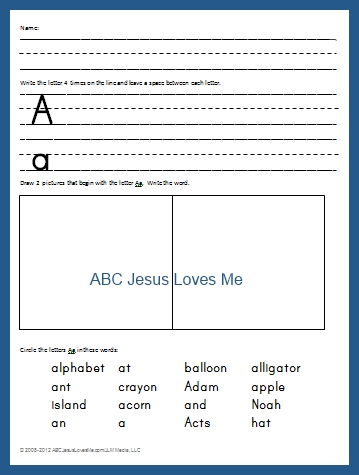 Ii Writing - Use the Writing worksheets to practice correctly writing the letter while saying the Letter Formation Chants, drawing pictures of words that begin with the letter, and finding the letter in words.
Ii Writing - Use the Writing worksheets to practice correctly writing the letter while saying the Letter Formation Chants, drawing pictures of words that begin with the letter, and finding the letter in words.
Letter I Activities - Use the ABCJesusLovesMe ideas to further study each letter. Ideas include Letter Posters, crafts, books, snack ideas, and computer games.
Each week includes a Book of the Week. These are considered to be the best books for older preschool-age children. Quality, classic books support other objectives learned in the lesson. Before reading a new story with the child, get in the habit of first taking a “Picture Walk.” It is called a “picture walk” because you “walk” through the pictures or preview the story without reading any words. This activity helps build interest in the story, aids in comprehension, develops imagination, and teaches the child to use visual clues as a reading strategy. Once familiar with the book, allow the child to fill in key words and rhyming words. Always discuss vocabulary while breaking the words into syllables. Then discuss the beginning, middle, and end as well as favorite parts of the book to further comprehension skills. Each week will also include a literacy activity to prepare the child for higher-level reading activities.
Book of the Week:
- Play a musical instrument every time the words "ku-plink, Ku-plank, ku-plunk" are read.
- Make blueberry muffins, jam, or pancakes.
-  Blueberry Pie Craft - Dip a small cotton ball or pompom into blue paint. Dab it onto a paper plate to create a blueberry pie. Glue on brown strips of paper for a lattice top.
Blueberry Pie Craft - Dip a small cotton ball or pompom into blue paint. Dab it onto a paper plate to create a blueberry pie. Glue on brown strips of paper for a lattice top.
Literacy: How to Care for a Book
- Slowly turn pages at the corner.
- Do not write in books unless it is a workbook and an adult tells you to.
- Keep books away from food, drinks, younger siblings, and animals; make sure your hands are clean.
- Do not turn down pages in a book. Use a bookmark instead.
- Do not fold the cover of a book back or lay an open book upside down.
- Shelve books vertically.
- Gently turn pages without bending or ripping them.
- Take care of books so that others can read them.
 At this age, some children have the development in place to begin putting phonetic sounds together to read. If the child is ready, I suggest using the Bob Books
At this age, some children have the development in place to begin putting phonetic sounds together to read. If the child is ready, I suggest using the Bob Books. These are what I used with my own children with great success. Be sure to read the back cover to get the gist of the story. Click to read suggestions and print the "Bob Books Reading Checklist." If you choose to begin the reading process, follow your child's leads and make each reading situation fun and positive. For more information, read "Teaching a Child to Read: Is Your Child Ready?" and Choosing a Reading Curriculum.
Sight Word:
- 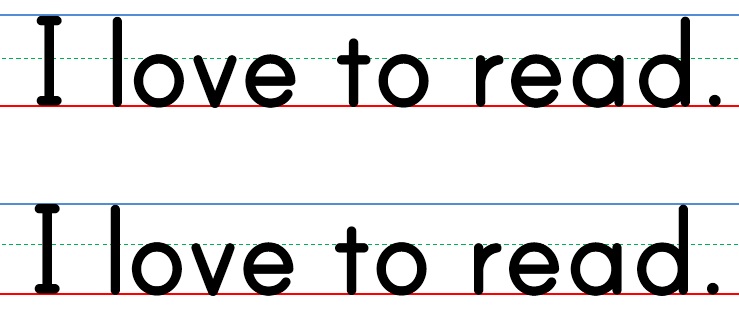 Sight words are included in the curriculum to provide the child with a foundation of reading. If your child is developmentally ready, help the child create a short sentence using the weekly sight word. Write the sentence on 3/4" Tracing Paper for the child using proper capitalization and punctuation. Instruct the child to copy the sentence. The goal is to have the large letters reach from the blue line to red line with appropriate lower case letters beginning at the green line, place finger spaces between the words, and add punctuation. This week create a sentence with the word "I."
Sight words are included in the curriculum to provide the child with a foundation of reading. If your child is developmentally ready, help the child create a short sentence using the weekly sight word. Write the sentence on 3/4" Tracing Paper for the child using proper capitalization and punctuation. Instruct the child to copy the sentence. The goal is to have the large letters reach from the blue line to red line with appropriate lower case letters beginning at the green line, place finger spaces between the words, and add punctuation. This week create a sentence with the word "I."
 Optional Addition: The 5 Year Sight Word Cards Printable is made up of 28 cards containing the sight words. Print, hole punch, and bind together for easy access and mobility.
Optional Addition: The 5 Year Sight Word Cards Printable is made up of 28 cards containing the sight words. Print, hole punch, and bind together for easy access and mobility.
Book of the Week: Blueberries for Sal
- Play a musical instrument every time the words "ku-plink, Ku-plank, ku-plunk" are read.
- Make blueberry muffins, jam, or pancakes.
-  Blueberry Pie Craft
Blueberry Pie Craft
Dip a small cotton ball or pompom into blue paint. Dab it onto a paper plate to create a blueberry pie. Glue on brown strips of paper for a lattice top.
Fine motor skills are activities that improve one’s ability to write and manipulate small objects. Gross motor skills involve large muscle movement (e.g. running, jumping, hopping etc.). These skills are important for pencil control, balance, and coordination. Each Lesson Plan includes an activity to improve the child’s fine and gross-motor skills. Also, refrain from using markers or pens in activities as they do not strengthen fine and gross motor skills as much as crayons and pencils. Be sure to look over the 4 Year Development Guide or 5 Year Development Guide so that you are familiar with developmental milestones for your child's age.
Along with fine and gross motor activities, each Lesson Plan in the 4 and 5 Year Curricula contains visual perception activities. Visual perception is the communication between the eyes and the brain, which is imperative for reading and writing. These activities can help correct visual perception issues as well as strengthen the brain and eye communication. While one activity may be difficult for your child, another may be simple.
Fine Motor Skill: Draw My Family Periodically the curriculum tasks the to draw his family. This can be daunting for some children. Begin by looking in the mirror and discussing how special God made the child. Then, demonstrate how to draw a person. Use simple shapes and lines while explaining what you are drawing. Let your child assist in the process. Later in the week, give your child a chance to try it unassisted For more ideas read, "Teaching Your Child How to Draw a Person."
Periodically the curriculum tasks the to draw his family. This can be daunting for some children. Begin by looking in the mirror and discussing how special God made the child. Then, demonstrate how to draw a person. Use simple shapes and lines while explaining what you are drawing. Let your child assist in the process. Later in the week, give your child a chance to try it unassisted For more ideas read, "Teaching Your Child How to Draw a Person."
Gross Motor Skill: Put the Fire Out Play "Put the Fire Out" - a fun outside activity that involves sidewalk chalk, water, and a sponge. Begin by drawing a ladder on cement with sidewalk chalk. Draw a fire at the top of the ladder. Place a bucket and a sponge at the bottom of the ladder. Have the child wet the sponge and jump between the rungs of the ladder to get to the fire. Once at the fire, squeeze the sponge over the fire to put it out! Idea from YourTherapySource.com
Play "Put the Fire Out" - a fun outside activity that involves sidewalk chalk, water, and a sponge. Begin by drawing a ladder on cement with sidewalk chalk. Draw a fire at the top of the ladder. Place a bucket and a sponge at the bottom of the ladder. Have the child wet the sponge and jump between the rungs of the ladder to get to the fire. Once at the fire, squeeze the sponge over the fire to put it out! Idea from YourTherapySource.com
Visual Perception Skill:  For the first week, use the Color Tracking Visual Perception Worksheets - Color Tracking 1, Color Tracking 2. Ask the child to color certain shapes, certain colors. Highlight the color words the correct color to help the child associate the word with the color. Use this activity to help the child search for items left to right and row by row. Another option is to assign each shape a colored candy. Ask the child to lay the correct colored candy on the corresponding shape.
For the first week, use the Color Tracking Visual Perception Worksheets - Color Tracking 1, Color Tracking 2. Ask the child to color certain shapes, certain colors. Highlight the color words the correct color to help the child associate the word with the color. Use this activity to help the child search for items left to right and row by row. Another option is to assign each shape a colored candy. Ask the child to lay the correct colored candy on the corresponding shape.
 For additional practice to confirm that the child's visual perception skills are ready for reading and writing, purchase the Visual Perception Workbook, 2nd Edition. Included are QR codes that grant access to exclusive videos explaining how to effectively teach each step of the Visual Perception process to your child. Additionally, enjoy watching a live demonstration of how I introduce each set of worksheets to a preschooler. Consider this workbook a captivating way to exercise both the eyes and the brain!
For additional practice to confirm that the child's visual perception skills are ready for reading and writing, purchase the Visual Perception Workbook, 2nd Edition. Included are QR codes that grant access to exclusive videos explaining how to effectively teach each step of the Visual Perception process to your child. Additionally, enjoy watching a live demonstration of how I introduce each set of worksheets to a preschooler. Consider this workbook a captivating way to exercise both the eyes and the brain!
Family Fun:
- 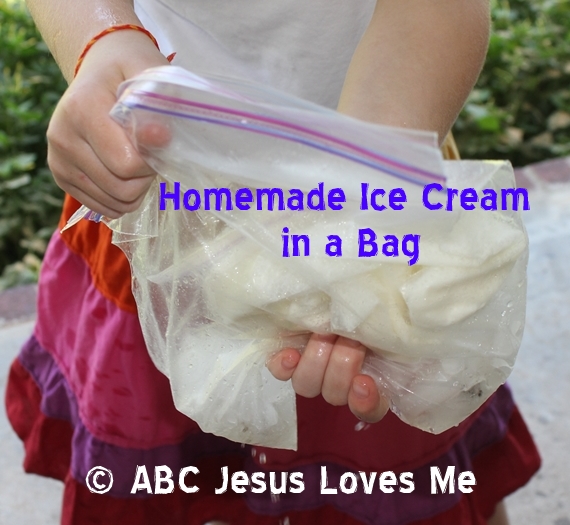 Create a family tradition of making homemade ice cream in a bag or in a coffee can.
Create a family tradition of making homemade ice cream in a bag or in a coffee can.
Ingredients:
1 tablespoon sugar
½ cup milk, cream, or half and half
¼ teaspoon vanilla extract
Place the three ingredients in a quart-sized ziptop bag or a small coffee can. Mix and seal the container very well. Because the seal may not hold through the mixing process, you may want to tape the seals closed. If possible, refrigerate this mixture for a few hours to speed up the freezing process. Place the well-sealed ziptop bag in a gallon-sized ziptop bag or the small coffee can inside a large coffee can. Place crushed ice cubes and approximately 1/2 cup rock salt inside the larger containers to surround the smaller bag or can. Seal the larger bag or coffee can very well. Then shake and roll the containers for 5-10 minutes until the mixture turns into ice cream. Carefully open the smaller container making sure that the water and salt freezing ingredients do not come in contact with the ice cream. Grab a spoon and enjoy!
First Day of 5 Year Curriculum:
 Print the First Day of Preschool or First Day of Kindergarten poster to create a precious photo op to remember today. Be sure to tag #ABCJesusLovesMe or @ABCJesusLovesMe when you post the image on social media!
Print the First Day of Preschool or First Day of Kindergarten poster to create a precious photo op to remember today. Be sure to tag #ABCJesusLovesMe or @ABCJesusLovesMe when you post the image on social media!
Warning: All information on the ABCJesusLovesMe website, on Facebook Groups under the ABCJesusLovesMe name, and on the Parenting to Impress blog is for general information purposes only. All the activities and ideas shared require adult supervision and children under the age of three should not participate in activities in which small pieces are involved. Also, what works with one child may not work with all children. ABCJesusLovesMe, as well as Parenting to Impress, contain suggestions and all should be taken simply as suggestions. Please seek the advice of a professional when questions arise.
This page may contain affiliate links. Please read our disclosure policy.